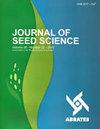Use of quantitative colorimetry and visual evaluation for color characterization of triticale seeds after phenol reaction
IF 1.2
4区 农林科学
Q3 AGRONOMY
引用次数: 3
Abstract
2Universidade Estadual de Londrina (UEL), Departamento de Agronomia, Caixa Postal 10.011, 86057-970 – Londrina, PR, Brasil. Uso de colorimetria quantitativa e avaliação visual para caracterização de cor de sementes de triticale após reação ao fenol ABSTRACT: Quantitative colorimetry can be used to characterize the color of triticale seeds submitted to the phenol test. This study aimed to characterize the color of triticale seeds after the phenol test by visual color evaluation and quantitative colorimetry using the CIELAB color space. The evaluated seeds came from 88 triticale genotypes from the IDR-Paraná Germplasm Bank. The colorimetric data for L (lightness) and chromaticity coordinates a* and b* of the seeds before and after phenol reaction were obtained using a Minolta CR400 colorimeter. The score scale ranged from 1 (very weak or absent color) to 9 (very dark color) and evaluated visually the seed color after phenol reaction. Seeds classified as score 1 showed mean values of 46.3, 6.6, and 16.4 for L, a*, and b*, respectively. On the other hand, seeds classified as dark or very dark showed values equal to or lower than 28.4 for L, 5.6 for chromaticity a*, and 6.0 for chromaticity b*. The use of colorimetric parameters showed a practical application and low subjectivity in the classification of the color of triticale seeds after phenol reaction.用定量比色法和目测法测定苯酚反应后小黑麦种子的颜色
2伦敦国立大学农学系,巴西邮政10.011,86057-970 -伦敦,PR,巴西摘要:定量比色法可用于小黑麦种子酚含量的测定。本研究利用CIELAB色彩空间,采用视觉显色法和定量比色法对小黑麦种子经苯酚试验后的颜色进行表征。所评价的种子来自idr - paran种质资源库中的88个小黑麦基因型。用美能达CR400比色仪测定苯酚反应前后种子的L(亮度)和色度坐标a*和b*的比色数据。评分范围从1(非常弱或没有颜色)到9(非常深的颜色),直观地评价酚反应后的种子颜色。评分1的种子,L、a*和b*的平均值分别为46.3、6.6和16.4。另一方面,被分类为深色或极深色的种子的L值等于或低于28.4,色度a*值为5.6,色度b*值为6.0。用比色法对苯酚反应后的小黑麦种子进行颜色分类,具有实用性和较低的主观性。
本文章由计算机程序翻译,如有差异,请以英文原文为准。
求助全文
约1分钟内获得全文
求助全文
来源期刊

Journal of Seed Science
Agricultural and Biological Sciences-Agronomy and Crop Science
CiteScore
2.00
自引率
30.00%
发文量
28
审稿时长
12 weeks
期刊介绍:
From 2017 the Journal of Seed Science (JSS) will circulate online version only.
Original scientific studies and communications, not yet published or submitted to another journal for publication and written in Portuguese or English, will be accepted for publication. For manuscripts submitted in English, the authors should provide an adequated version.
The SCIENTIFIC COMMUNICATION is a category of scientific manuscript which describes a technique, an equipment, new species or observations and surveys of limited results. It has the same scientific rigor as the “Scientific Articles” and the same value as a publication. The classification of a manuscript as a SCIENTIFIC COMMUNICATION is based on its content and scientific merit but it can be a preliminary study, simple and not definitive on a certain subject, with publication justified by its uniqueness and contribution to the area.
The Editorial Board of the JSS may invite leading authors of recognized reputation to compose specific Review Articles covering topics of their specialization that will convey to the scientific community the state-of-the-art knowledge related to the specific theme.
 求助内容:
求助内容: 应助结果提醒方式:
应助结果提醒方式:


